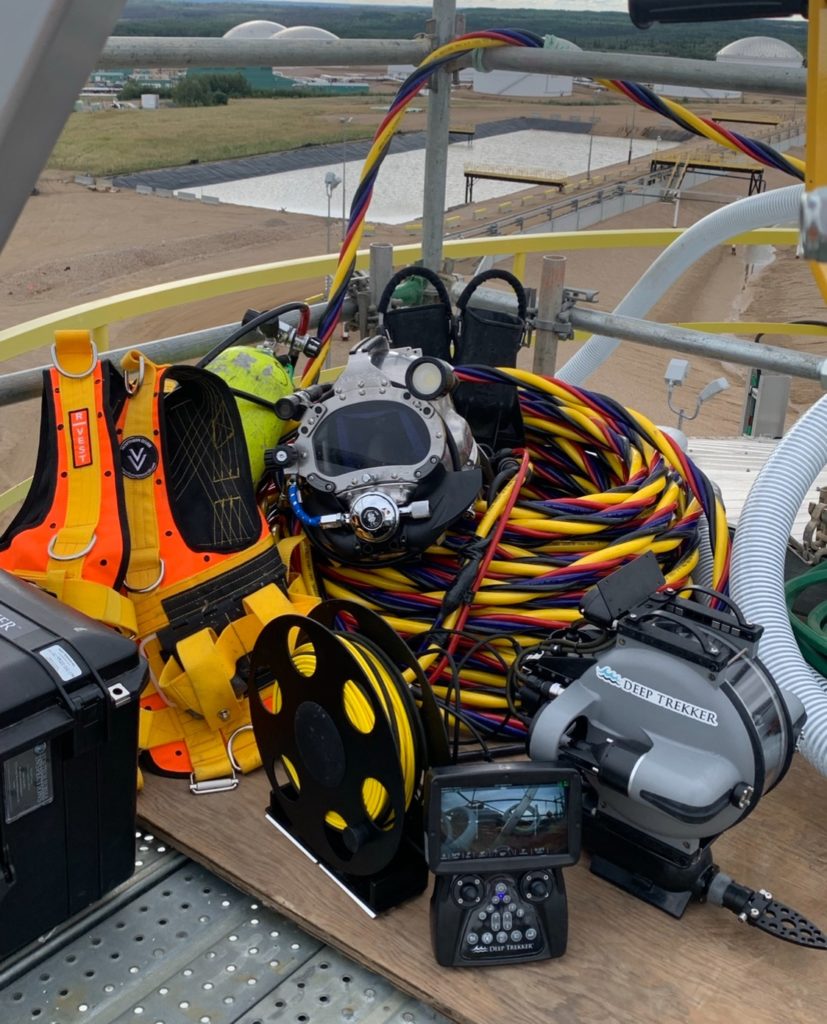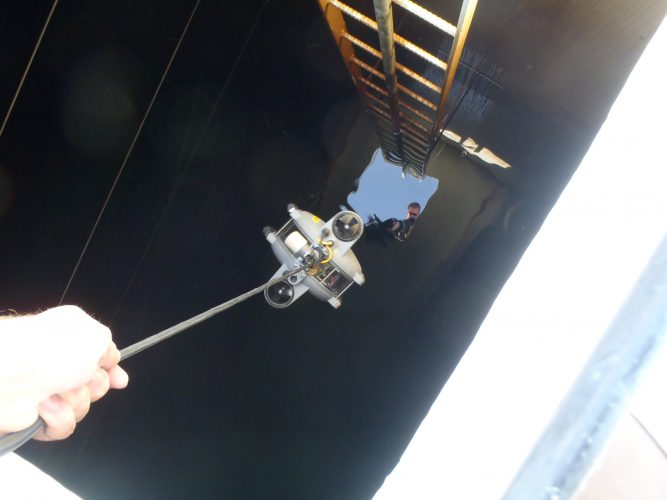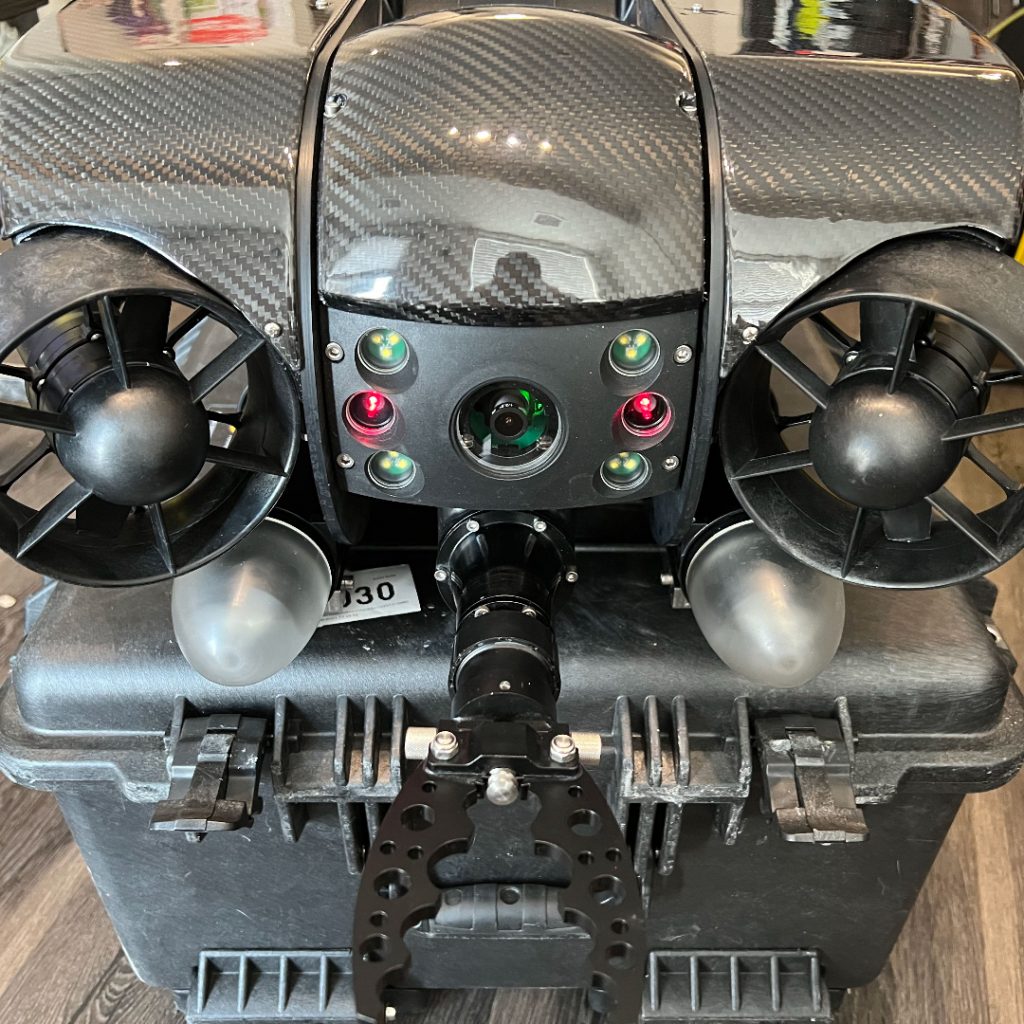Ven-Tech Subsea brings peace of mind to customers with regular and efficient mini ROV RESERVOIR INSPECTION
Ven-Tech Subsea is a commercial diving company based in BC and Alberta, Canada. Operating since 2015, Ven-Tech Subsea recently added a Deep Trekker mini remotely operated vehicle (ROV) to their team to improve potable water and ROV RESERVOIR INSPECTION.
Ven-Tech Subsea consists of a team of 8 highly trained divers experienced in everything from underwater welding, inspections, cleaning and maintenance. Their acquisition of Deep Trekker’s DTG3 ROV unit has allowed Ven-Tech Subsea to significantly reduce costs associated with performing services for their client base.
Ven-Tech Subsea has been providing marine communities with commercial diving services for almost 10 years and have integrated a specialised focus in potable water tank and reservoir inspections for the past decade. Ven-Tech Subsea explains that frequent potable water tank and reservoir inspections are important to maintain and improve water quality, extend the service life of the reservoir and/or structures, and to provide peace of mind. ROV RESERVOIR INSPECTION
Over time, sediment can build up in storage facilities and compromise the quality of the water and the structural integrity of tanks may also be depleted. By performing regular inspections, maintenance can be carried out at the first sign of necessity reducing potential costs for the plant operators. After years of completing inspections with divers, Ven-Tech Subsea recently added the Deep Trekker DTG3 ROV to their arsenal of tools to perform inspection tasks.
ROV RESERVOIR INSPECTION
Deep Trekker Inc.is a Canadian manufacturer of underwater inspection tools. Their underwater drones (ROVs) and portable CCTV pipe crawler systems have been providing the utility and commercial diving industries with robust equipment for the past 10 years. Deep Trekker’s flagship product, the DTG3 ROV, is currently being used for thousands of projects around the globe ranging from aquaculture farm inspections, to research investigations, to search and rescue operations and utility maintenance. Deep Trekker’s underwater drone was chosen by Ven-Tech Subsea for its easy deployment and operation, robust build and affordable price tag. ROV RESERVOIR INSPECTION

Ven-Tech Subsea, took the time to comment on how the DTG3 ROV has improved their potable water tank and reservoir inspections. “Using the Deep Trekker just makes things a lot easier, a lot more efficient and a lot cheaper. Both for the client and myself”. He explained that due to commercial diving regulations, a dive inspection requires a team of four divers to be on site, as opposed to the ROV which requires one operator. This can increase per inspection costs by $3000.00 compared to using the underwater drone because of the time, equipment and preparation required before divers get in the water.
“Using the Deep Trekker just makes things a lot easier, a lot more efficient and a lot cheaper. Both for the client and myself.”
A typical reservoir inspection in a 500,000 gallon capacity tank takes approximately 30 minutes with the Deep Trekker ROV, start to finish. Inspection time by divers requires about the same amount of time. However, the additional preparation time required for divers significantly adds to the cost. A commercial diving company such as Ven-Tech Subsea understands the importance of commercial diving and human judgement while underwater. However, for inspection tasks such as tank and reservoir maintenance, the ROV is the perfect system to assess and record current conditions and to save the company and clients’ time and money.
Ven-Tech Subsea also explains that while it is possible to use divers in potable water tank inspections, the ROV is much easier to disinfect and offers more peace of mind to the client. Everything is sealed and contained within the DTG3 ROV so there are is less maintenance, preparation and follow up required to ensure that the equipment is ready for an inspection.

With internally mounted lithium ion batteries, operators of the DTG3 ROV receive between 6-8 hours of run time on a single charge. The complete portability and next-to-no maintenance that the Deep Trekker ROVs offer are attractive and desirable features for Ven-Tech Subsea. Ven-Tech Subsea explains that having a battery powered unit works perfectly for the tasks they undertake. “It’s a complete unit. I can take a little 110 inverter along with me. I can charge it up from the van on our way because it has the 110 inverter right built in the van. It’s just this little unit that’s self-contained and it’s just a real simple unit for us to use.”.
The nature of the Deep Trekker DTG3 ROV also makes it the ideal equipment for completing elevated potable water tank inspections. “Some potable water tanks or reservoirs can be over 100 feet high. I added an extended tether to the ROV so that we can operate the system from the service van while inspecting inside the tank or reservoir. With a diver, it can be done, but we personally have never done one at that height just because it costs an extra thousands of dollars in boom trucks and logistics just to get the inspection done. Whereas you can get the same thing done in a 110 foot tower as you would in a 10 foot tower with the ROV.”.
Ven-Tech Subsea has outfitted their van so that the operator can monitor the ROV from within and have included a seat for the client to watch the inspection as well. Aside from the ROV tender working from the top of the tower, the operators can remain on the ground to complete the inspection. By setting it up like this, Ven-Tech Subsea is able to offer a personal experience with their client during the inspection process.
Let us help find the right fit for your inspection and tank cleaning projects CONTACT INDUSTRY SPECIALIST
With internally mounted lithium ion batteries, operators of the DTG3 ROV receive between 6-8 hours of run time on a single charge. The complete portability and next-to-no maintenance that the Deep Trekker ROVs offer are attractive and desirable features for Ven-Tech Subsea. Ven-Tech Subsea explains that having a battery powered unit works perfectly for the tasks they undertake. “It’s a complete unit. I can take a little 110 inverter along with me. I can charge it up from the van on our way because it has the 110 inverter right built in the van. It’s just this little unit that’s self-contained and it’s just a real simple unit for us to use.”.
The nature of the Deep Trekker DTG3 ROV also makes it the ideal equipment for completing elevated potable water tank inspections. “Some potable water tanks or reservoirs can be over 100 feet high. I added an extended tether to the ROV so that we can operate the system from the service van while inspecting inside the tank or reservoir. With a diver, it can be done, but we personally have never done one at that height just because it costs an extra thousands of dollars in boom trucks and logistics just to get the inspection done. Whereas you can get the same thing done in a 110 foot tower as you would in a 10 foot tower with the ROV.”.
Ven-Tech Subsea has outfitted their van so that the operator can monitor the ROV from within and have included a seat for the client to watch the inspection as well. Aside from the ROV tender working from the top of the tower, the operators can remain on the ground to complete the inspection. By setting it up like this, Ven-Tech Subsea is able to offer a personal experience with their client during the inspection process.

In addition to potable water tank and reservoir inspections, Ven-Tech Subsea has used their Deep Trekker ROV to do wharf inspections and maintenance. They are planning on using their underwater drone to complete more of these tasks in the future. Ven-Tech Subsea commented that “It’s a rugged, tough piece of equipment that can handle bumping around a wharf.”
Deep Trekker Inc. offers a range of models of mini-ROVs as well as a self-contained, portable pipe crawler system. ROVs systems can reach depths of 150 or 305 meters and the pipe crawler is rated for 50 metres. Deep Trekker continues to provide commercial dive companies with a tool that can be used to compliment the dive work. Various add-on tools and options are available to improve lighting, manipulate objects, test water, and more.
To learn more visit www.deeptrekker.com
For information on Ven-Tech Subsea visit click Here.
